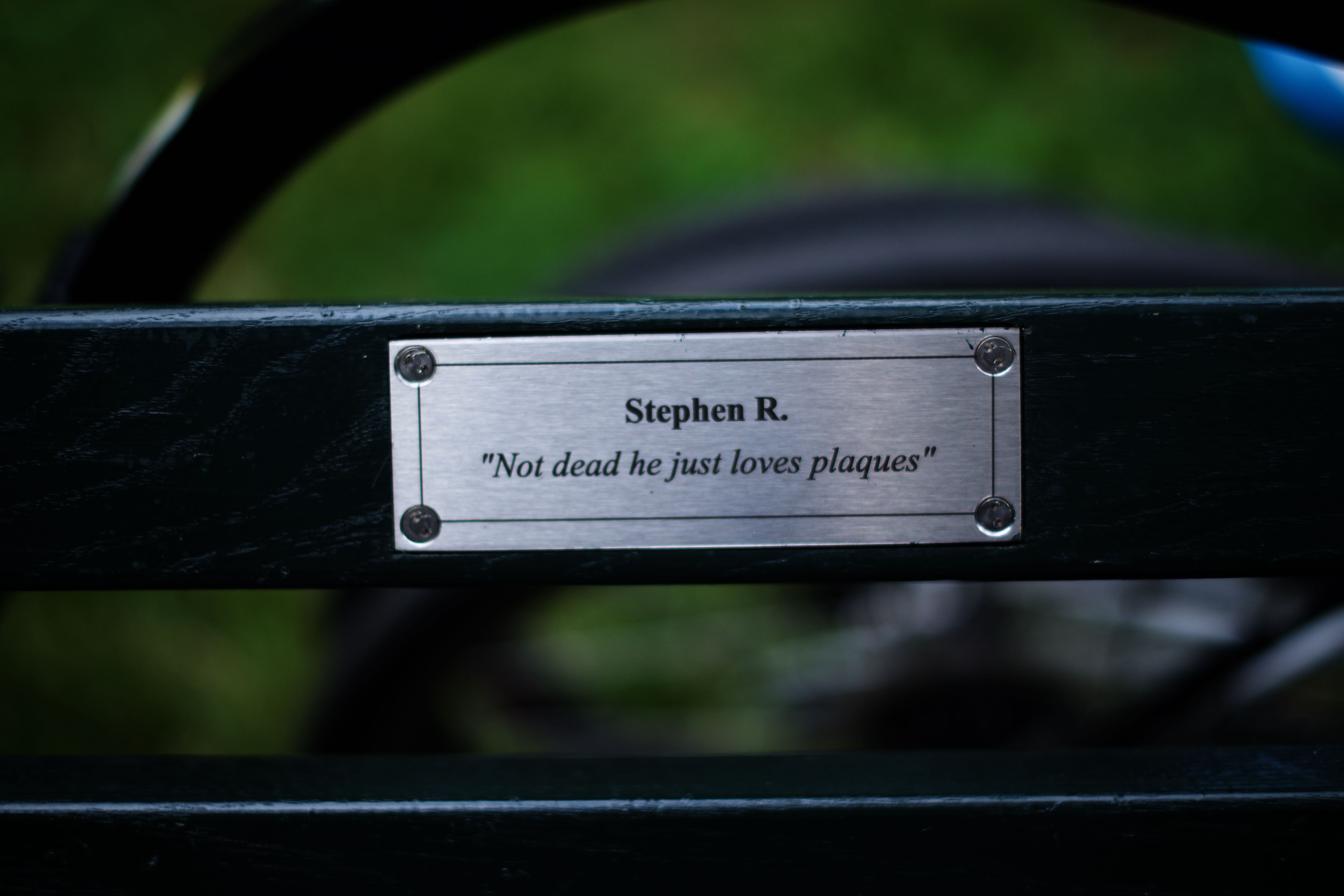During Labor Day weekend, I was walking around Central Park playing a game with the memorial plaques on the benches. The game, which I made up and you are more than welcome to play as well, is called Dog or Human. The object of the game is to guess whether the plaque is about a dog or a human. This game can also be played in other settings, such as in other parks with memorial plaques or in coffee shops while eavesdropping on other conversations which may be about a dog or a human. It can be surprisingly difficult. Consider these real Central Park bench plaques:
FOR GROVER & NELL
WHO LOVED THE PARK
One more:
FOR GRACIE AND DAISY
FOR ALL THE WALKS
AND COMPANIONSHIP
JOHN AND MARJORIE
During the course of this game, I came across one plaque that was definitely not like the others:

I did what anyone does in 2019 when they see something funny. I took a photo of it. Then I did what anyone does who has an attention span of a squirrel. I forgot about it. Until last week.
I was going through my photo album, photo by photo, to avoid writing a different article which unsurprisingly has not been published yet, until I had no more photos to look at. At which point I did what most people who can’t help themselves would do when they see something funny in their camera roll. I tweeted it.
A few hours later, Stephen R. replied:
Naturally, I had to find out more about how this plaque came to be. The plaque has a more interesting backstory than I would have guessed. Stephen R. went rogue.
In September of 2018, Stephen Rubino had an idea. He had long been fascinated with the plaques on benches in Central Park and liked how they seemed egalitarian. Some were by celebrities, others were marriage proposals. Some were simply well wishes to whoever happened to be reading them. A surprisingly large number may or may not have been dedicated to dogs. They were for the people, by the people of New York in one of the world’s great public spaces.
Rubino, a producer and part-time comedian, wanted to have a plaque, too. He likes the cutesy ones that are clearly inside jokes (”For Kikko, Because...There’s something in the way she moves. I love you, K”) but wishes there were fewer straight dedications that say, as he put it, “‘John, 1930-1999’ or whatever.”
He looked up how much they cost. The New York City Parks Department, through the Central Park Conservancy, charges $10,000 per plaque as a fundraising tool. Not so egalitarian after all.
That was when Rubino had his dumb idea: “I wondered if I could just make a fake one and put it on anyways.”
Rubino’s plaque idea originated from a message he sent his friend saying, "If I die please make a plaque on a bench in Central Park that says ‘he loved plaques.’” But he also drew inspiration from Joe Reginella’s memorials to events that never happened, like the Brooklyn Bridge elephant stampede, the 1963 Staten Island ferry disaster when the ferry was attacked by a giant octopus, or when Mayor Ed Koch released wolves in an anti-graffiti initiative. Rubino thought these memorials to non-existent disasters were funny, but also appreciated how they made people think more carefully about what is honored in public and why.
Rubino opened up Google Maps and found an engraving company near Central Park. He emailed them and asked how much it would cost to make a plaque that looks like the ones in Central Park, under the guise that it was for a movie prop.
As it happened, Rubino emailed the very company that does the engraving for Central Park’s plaques, which Rubino said was “totally by chance.” The company quoted him $150. A little steep for a “dumb joke,” Rubino recalls thinking. But in the meantime, his friend found the screws the Parks Department uses for the plaques. Between this and accidentally emailing the very company that makes the official plaques, it felt destined, a small price to pay for New York City history. The company told him it would take about 10 business days. No problem, Rubino said, his shoot didn’t start for another two or three weeks.
Rubino ruled out installing the plaque on a virgin bench because it would stand out and not look right, due to the fact that the plaques are carved out of the bench itself. But that meant he had to remove a plaque already installed. He found one that read: “Bloomingdale's, the Outlet Store.”
“I figured no one would miss that one,” Rubino said.
(A 2016 New York Times article claims the park doesn’t allow advertising on the plaques, but the official Adopt-A-Bench form makes no mention of any anti-advertising policy. In any event, there is still a bench in Central Park with a plaque for Bloomingdale’s of 59th Street.)
Later that night, Rubino and his girlfriend returned, took off the Bloomingdale’s plaque, and installed his. They returned the next day to document their triumph.

“Always read the plaque” is the unofficial slogan of the popular podcast 99 Percent Invisible. Our everyday environments have stories to tell, both in plaque and non-plaque form, and only by stopping and paying attention to our world can we learn about them. “Always read the plaque” is another way of saying the place you’re in existed before you. It has a life of its own. It’s a mantra that reminds me I am but a guest in this world. It’s best to put things back where I found them.
I take this mantra seriously, not just in Central Park. For example, I first learned about the Palmer Raids—a horrific episode in early 20th Century America when attorney general Richard Palmer cracked down on immigrant groups erroneously suspected of being communists—when I stopped to read a plaque outside a church during a pit stop in Stroudsburg, Pennsylvania. (The plaque, in an exemplary case of historical whitewashing, merely says Palmer “[prosecuted] those suspected of being anti-American.”)
Because Roman Mars, the host of 99 Percent Invisible and the patron saint of plaque-reading retweeted my tweet, I got a lot of good plaque replies. They’re dumb in the way that Rubino’s plaque is dumb. They say nothing of consequence.
But they’re brilliant in the way Rubino’s plaque is brilliant. They make us laugh and, hopefully, consider what it really means to be of consequence.
They also serve as a necessary and needed counterbalance to the seriousness of most plaques. After all, between the time we emerge from a person who once sat on a bench with a plaque to the time we have a bench dedicated to us with a plaque, we have lives to lead. They might even be enjoyable lives during which we see a funny plaque. And perhaps the plaques remind us of all the other guests who have borrowed these benches, and give us hope that one day we may cease being guests and find our own home.
After I asked Rubino about the plaque’s origins, we ended up chatting for a while, as fellow plaque aficionados, about plaques. This was what most people would consider a boring conversation, so eventually, the conversation meandered to New York more broadly, and how some people on a Reddit thread got upset he removed the Bloomingdale’s plaque for reasons one can only ascribe to Reddit being a morally vacant hellscape. It’s an argument for which Rubino has little sympathy. “If you can't handle some minor anti-corporate vandalism,” he suggested, “don't live in New York.”
That being said, Rubino plans to make Central Park whole when he dies. “I would like $10,000 of my estate to go towards a legit park bench that says ‘Stephen R.—OK, NOW he's dead’ or something like that,” he said. He’s never told anyone that before, which made me feel honored, like the moment deserved a plaque of its own. I don’t know if a VICE.com article counts as a legally binding will, but that’s for the courts to decide.
We debated whether that plaque should be placed right next to the existing one on the same bench or on the other side of the park. I preferred the same bench, but Rubino’s for across the park. “I'll leave it up to the executor of my will,” he decided. “Either way is pretty good.”
from VICE https://ift.tt/3aliFyM
via cheap web hosting
No comments:
Post a Comment